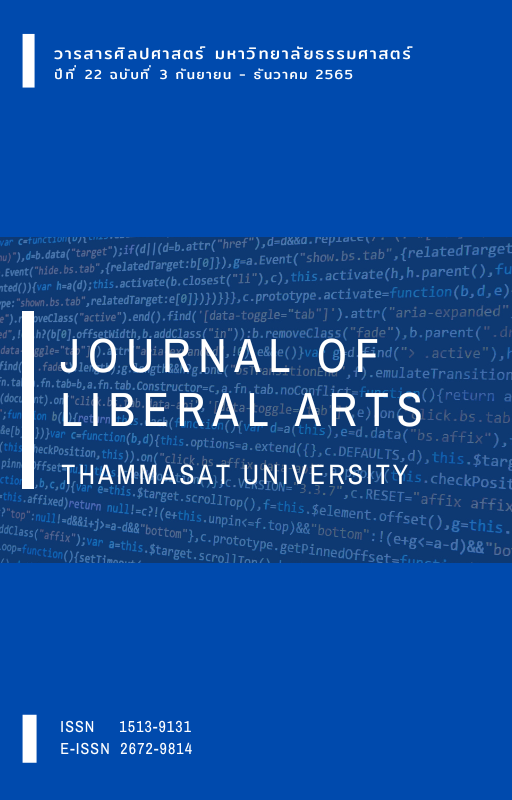The Image of Wang Xi-Feng in the Dream of the Red Chamber and The Life of Dai Yu
Main Article Content
Abstract
This research analyses the images and the representation of Wang Xi-Feng, a character in two dramas, The Dream of the Red Chamber (version of 1987, 1996 and the 2010 version, respectively) and the Life of Dai Yu in 2010. The study employed the imaging concept and the character presentation as the conceptual framework. In the dramas, the five aspects of the main character, i.e.: 1) her ability; 2) the brutal actions and the actions that were against the tradition of Chinese feudalism; 3) wifehood; 4) motherhood; and 5) the painful experiences in life, were studied and emphasized as the extent of the study. The results found that the character’s brutal images and the actions against the tradition of society were vividly presented, demonstrating the character’s ability to manage the situations in her life. The images of wifehood and motherhood were the least presented. In the four dramas, the images of the painful experiences in life were presented in very distinctive ways. It reflected how in the Chinese feudal system women were always subject to the strict traditions of Sāncóng sìdé (obeying three men and having the four virtues) which was used as the rationale to limit their roles in the society. The plots of the four dramas are portrayed based on the original literary works, especially on Wang Xi-Feng’s ability, her cruel actions and her downfall. As for the end of Wang Xi-Feng’s life, the four dramas presented it differently. The dramas reflected Wang Xi-Feng’s good deeds, even though her brutality could not be totally erased. However, the dramas helped the viewers to have more understanding on this character’s behaviours by portraying how hard she tried to retain her social status and roles in the society. Moreover, the four dramas clearly mirrored the hardship of women’s lives under Chinese feudalism.
Downloads
Article Details

This work is licensed under a Creative Commons Attribution-NonCommercial-NoDerivatives 4.0 International License.
References
จิรมน สังข์ชัย. (2562). การดัดแปลงนวนิยายชุดผ้าของ พงศกร เป็นบทละครโทรทัศน์. วารสาร วิชาการ มหาวิทยาลัยหอการค้าไทย ฉบับมนุษยศาสตร์และสังคมศาสตร์, 39(1), 137-161.
ชญาน์ทัต วงศ์มณี, และ รุ่งนภา พิตรปรีชา. (2553). ภาพลักษณ์ของผู้หญิงที่ปรากฏในข่าวประชาสัมพันธ์ละครโทรทัศน์. วารสารการประชาสัมพันธ์และการโฆษณา, 3(3), 55-76.
ชิว ซูหลุน. (2551). แนวคิดหลักอมตะวรรณคดีจีนความฝันในหอแดง. วารสารจีนวิทยา, 2, 50-59.
เชียน เหริน. (2555). ผู้หญิงในอุดมคติจากมุมมองทางวัฒนธรรมไทยกับจีน การศึกษาเปรียบเทียบนางเอกในวรรณกรรมเรื่อง สี่แผ่นดิน และ ความฝันในหอแดง [วิทยานิพนธ์ปริญญามหาบัณฑิต]. จุฬาลงกรณ์มหาวิทยาลัย.
ธนัสถ์ สุวัฒนมหาตม์. (2560). หวังซีเฟิ่ง ดาวร้ายในสิบสองดรุณีแห่งจินหลิง ใน ดาวร้ายในประวัติศาสตร์วัฒนธรรมจีน. ชวนอ่าน.
นัยน์พัศ อธิษฐ์พัส. (2561). ความย้อนแย้งแห่งเสรีภาพในนวนิยายเรื่อง ความฝันในหอแดงและนวนิยายของมั่วเหยียน [วิทยานิพนธ์ปริญญาดุษฎีบัณฑิต]. จุฬาลงกรณ์มหาวิทยาลัย.
พัชราวลี จินนิกร. (2559). การศึกษาภาพลักษณ์ของตัวละครหญิงในวรรณกรรมเรื่องผู้ชนะสิบทิศ [วิทยานิพนธ์ปริญญามหาบัณฑิต]. มหาวิทยาลัยบูรพา.
ภูเทพ ประภากร. (2564). คุณค่าสตรีตามแนวคิดปิตาธิปไตยในสังคมศักดินาจีนจากวรรณคดีเรื่อง ความฝันในหอแดง. วารสารอักษรศาสตร์, 50(1), 17-41.
ทิสวัธ ธำรงสานต์. (2560). ตีความ เลียนแบบ และแปลงสาร เจ้าชายน้อย: จากนวนิยายเชิงปรัชญาสู่แผ่นฟิล์ม. วารสารมนุษยศาสตร์, 24(1), 142-170.
รัตนศักดิ์ ก้อนเพชร, และ กาญจนา วิชญาปกรณ์. (2561). “สตภาพลักษณ์วีรบุรุษนอกกฎหมาย” ของตัวละครเอกฝ่ายชายในวรรณกรรมของไม้เมืองเดิม. วารสารศิลปศาสตร์ มหาวิทยาลัยแม่โจ้, 6(2), 147-166.
Cao, X. Q., & Gao, E. (2019). ความฝันในหอแดง《红楼梦》. ฉางขุน长春:สือไต้เหวินอี้ 时代文艺出版社.
Ding, M. (2006). การเปรียบเทียบภาพลักษณ์ของพานจินเหลียนกับหวังซีเฟิ่ง 潘金莲与王熙凤形象比较. Journal of Yangzhou College of Education, 24(4), 19-22.
He, W. G. (2017). การวิเคราะห์ภาพลักษณ์หวังซีเฟิ่งจากละครและภาพยนตร์ความฝันในหอแดง 论《红楼梦》电视剧中的王熙凤形象. Journal of Luoyang Normal University, 36(10), 26-30.
Liu, Sh. F. (2019). ความฝันในหอแดงที่อ่านไม่รู้สิ้น เหล่าตัวละครที่งดงามมิรู้จบ 看不够的 红楼梦,品不完的众人生. 沈阳:辽宁人民出版社.
Liu, X. W. (2016). หลิวซินอู่ไขปริศนาความฝันในหอแดง (เล่มแรก) 刘心武揭秘《红楼梦》(上). หนันจิง 南京: อี้หลิน 译林出版社.
Ma, M. Q. (2019). วิเคราะห์อุปนิสัยและภาพลักษณ์ของหวังซีเฟิ่งจากความฝันในหอแดง 浅谈《红楼梦》中王熙凤人物形象及性格. MotherLand Journal, 4, 99-101.
Su, E. Q. (2020). วิเคราะห์ภาพลักษณ์ความเป็น “ภรรยา” ของหวังซีเฟิ่งจากความสัมพันธ์ตัวละครสามกลุ่ม三重视角解读王熙凤“妻”之形象. Northern Literature Journal, 15, 37-39.
Wei, X. l. (2018). วิเคราะห์ภาพลักษณ์ตัวละครหวังซีเฟิ่งจากความฝันในหอแดง 浅析《红楼梦》中王熙凤人物形象. Literati and Artist of China Journal, 1, 107.
Xu, K. X. (2019). พิเคราะห์วรรณคดีจีนจากละครในมิติด้านวัฒนธรรมชั้นสูงและด้านมวลชน กรณีศึกษา การดัดแปลงละครความฝันในหอแดง ปี ค.ศ. 1987 และ ปี ค.ศ. 2010 浅谈经典名著在影视语境中的大众与精英文化——以对比87版、2010版《红楼梦》改编为例. Global Premiere Journal, 4, 32.
Yu, Y. (2018). ศึกษาภาพลักษณ์หวังซีเฟิ่งจากความฝันในหอแดง 《红楼梦》中王熙凤形象研究. Journal of Guangxi Science & Technology Normal University, 33(4), 57-59.
Zhang, Y. (2012). Comparison Between 87 Version and 2010 Version of The TV Series “Dream of Red Mansions”. (Broadcast and TV Art Subject) Zhejiang Normal University, China.


